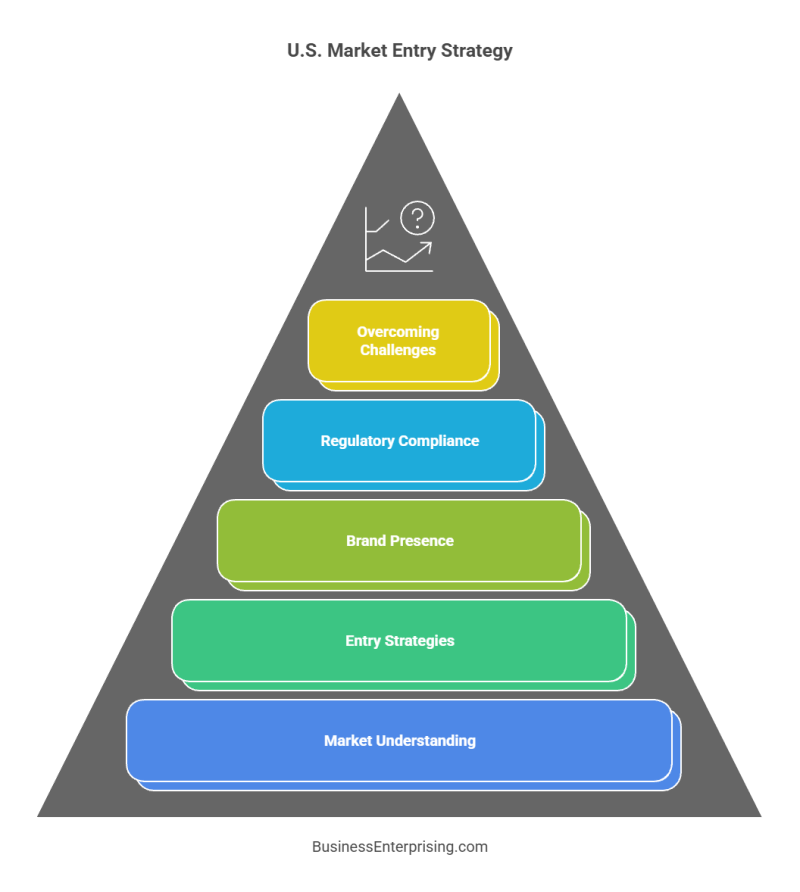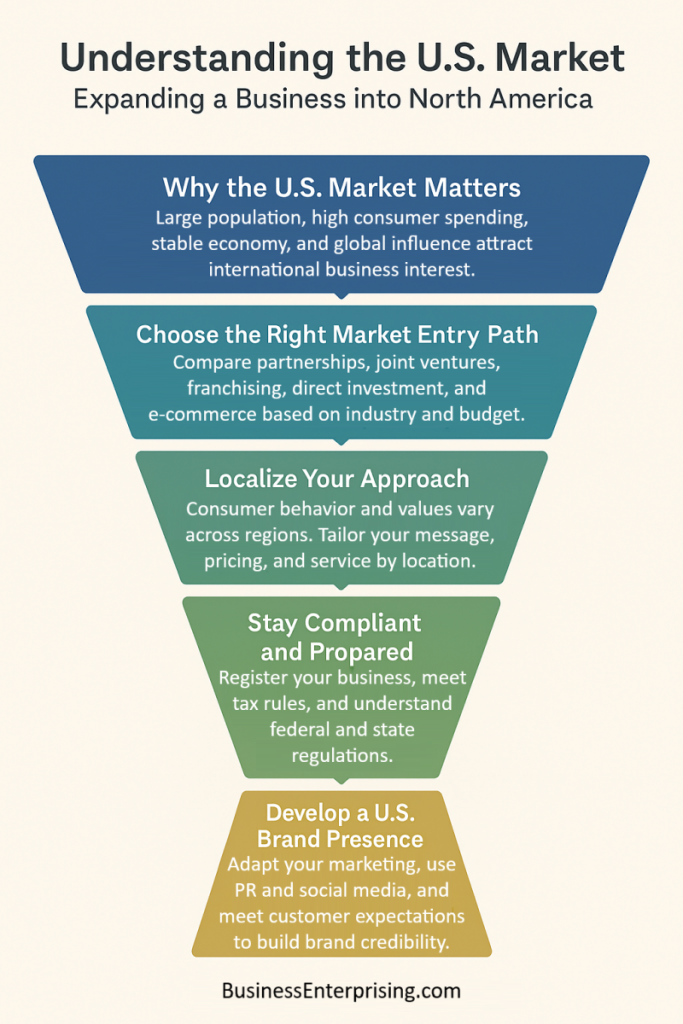
Each part of the U.S. has its own customer preferences, pricing expectations, and cultural values. Additionally, you will find different laws, taxes, and regulations from one state to the next. That makes it hard to apply a single strategy across the entire country. Therefore, you need to stay flexible and localize your approach where needed.
Expanding into the U.S. takes more than a good product or service. You also need a clear brand presence, trusted operations, and strong local support. However, many companies underestimate the importance of messaging, service expectations, and regional behavior. These factors affect your growth rate and long-term success.
You will also face new business systems, different hiring practices, and unfamiliar legal requirements. Therefore, doing your homework up front gives you a stronger position. Small decisions early on can save you time and money later.
This article shares practical insights about entering the U.S. market and how to avoid common pitfalls. The goal is to help you move forward with more clarity and fewer surprises. With the right preparation, your business can compete and grow in one of the largest markets in the world.
Why the U.S. Market Matters for Global Expansion
Understanding the U.S. market is important if you’re thinking about expanding your business internationally. The United States has over 330 million people, offering a massive base of potential customers. Its population includes a large percentage of high-income households, which means strong buying power. Businesses around the world target the U.S. because its consumers regularly spend on both essentials and discretionary products.
The U.S. economy is among the most stable and resilient. This stability makes long-term planning easier and lowers the risk for international businesses. Additionally, the country remains a global leader in innovation and technology. Companies that operate in the U.S. can often access the latest tools, platforms, and business practices ahead of other markets.
Because of the country’s diversity, your products can reach a broad range of customer groups. You’ll find regional differences in preferences, pricing expectations, and brand loyalty. That variety gives your business room to experiment, test, and refine your approach. If your product succeeds in one region, you can often scale it across others with modifications.
Moreover, the U.S. market holds influence far beyond its borders. Many trends, technologies, and consumer behaviors that start in the U.S. spread globally. By operating in the U.S., you not only reach American consumers, but also gain visibility across international audiences. You also gain credibility by being active in a market known for high standards and strong competition.
Expanding into the U.S. gives your company access to valuable resources and a well-developed business environment. The combination of size, spending power, and economic strength makes the U.S. one of the most attractive markets worldwide.
Key Market Entry Strategies for North America
Choosing the right strategy to enter the U.S. market depends on your goals, resources, and business model. Different industries benefit from different approaches. Partnerships are a common starting point because they let you share resources and gain local insights. However, partnerships can also limit your control and slow down decision-making.
Joint ventures work well if you need deeper integration with a local partner. They help with compliance and local trust. However, they also require more structure and a long-term commitment. You need clear terms to avoid confusion. Direct investment, such as opening your own office or facility, gives you full control. It also helps build a long-term presence. Still, this approach takes more time, money, and local expertise.
Additionally, franchising can work well for service industries and retail. It allows you to expand with less capital by using local operators. You supply the brand and systems. They run the daily operations. This strategy helps you grow quickly, but it depends heavily on strong franchise management. If done poorly, your brand reputation can suffer.
E-commerce gives you fast access to customers without a physical presence. You can test demand, gather feedback, and scale selectively. However, logistics, returns, and local regulations may still add complexity. E-commerce is ideal for product-based businesses, especially in consumer goods and lifestyle categories. Understanding the U.S. market includes knowing which model fits your business and risk tolerance. Each option has its own strengths. The right choice often depends on how much control, capital, and flexibility you need to succeed.
Understanding Regional and Cultural Differences
Understanding the U.S. market includes learning how customer preferences shift across regions. The U.S. is not one uniform audience. Each region has its own consumer habits, cultural values, and expectations. A marketing message that works well in one state may fall flat in another. Because of that, you need to consider local behaviors before launching anything nationally.
For example, shoppers in large metro areas often expect fast service and modern branding. However, smaller towns may favor familiarity and personal connection. Additionally, pricing expectations can vary by region. What’s considered affordable in one state may be seen as expensive in another. Your pricing, packaging, and promotions should reflect these local realities.
Language plays a role too. While English is standard, different dialects and phrasing affect how people interpret your message. Some areas have large bilingual populations. Therefore, using both English and Spanish in your content might help you build trust and reach more people.
Cultural values also influence buying decisions. For example, environmental concerns may drive consumer choices in one state. Meanwhile, product durability or local sourcing might matter more elsewhere. Therefore, knowing what matters most to your audience helps you improve your message and offer.
Regional habits affect everything from shipping expectations to customer service preferences. Therefore, you’ll want to adjust your operations to meet local standards. A one-size-fits-all approach will likely waste time and reduce effectiveness. By treating each region with care, you’ll find more success and build long-term loyalty.
Regulatory Compliance and Legal Considerations
Understanding the U.S. market also means understanding the legal system you’re entering. The U.S. has both federal and state-level regulations. You must follow rules at both levels to avoid fines or delays. Business registration is one of the first legal steps you’ll face. You need to choose a structure, register your business, and get the proper licenses.
Additionally, each state may require different documents and processes. Some states are more business-friendly than others. Therefore, it’s important to choose your base of operations carefully. You’ll also need to apply for a federal tax ID. This is required to pay taxes, open a bank account, or hire employees.
Tax obligations vary by location, income level, and business structure. You may owe federal income tax, state income tax, and sales tax. Therefore, keeping accurate records will help you avoid penalties later. Some industries also face strict compliance rules. For example, food, health, and financial services must meet high standards. These standards may apply to both your products and your marketing claims.
Additionally, hiring employees adds another layer of legal responsibility. You must follow wage laws, workplace safety rules, and anti-discrimination guidelines. If you plan to hire remotely, these laws still apply. Therefore, you should review labor rules for each state where your team operates.
Legal compliance can feel complex at first, but it protects your business from serious risk. Understanding the U.S. market includes learning how to operate legally and professionally from the beginning. That foundation helps you grow with fewer setbacks.
Building a U.S. Brand Presence
Building a strong U.S. brand presence takes more than translating your message. You need to adapt your marketing for American expectations. That includes how your product looks, how you speak to customers, and where your brand appears. Therefore, you should study what American buyers respond to before you launch your campaigns.
Understanding the U.S. market helps you adjust your brand voice and visuals. Many brands succeed by simplifying their message and focusing on benefits. American consumers expect clarity and value. They also prefer consistent branding across every platform, including online and offline. Additionally, your website should feel familiar and easy to use.
Public relations can help you gain early traction. A press release, media mention, or expert quote builds authority. Therefore, investing in a local PR strategy may help introduce your brand more effectively. You’ll also want to monitor what people say about you. Responding promptly builds trust and shows professionalism.
Social media is another key piece of your brand presence. However, each platform works differently. What works on Instagram may not work on LinkedIn. Therefore, you need a channel-specific strategy that fits your audience and goals. Use a mix of visuals, customer feedback, and useful tips to stay relevant.
Trust-building takes time. Customers need to see proof that your product delivers. Therefore, use reviews, testimonials, and guarantees when possible. Americans often check for those before making a purchase. Clear return policies, fast support, and honest messaging go a long way. If you focus on consistency and credibility, your brand will gain traction over time.
Common Challenges and How to Overcome Them
Expanding into the U.S. comes with challenges that can slow progress or increase costs. However, most of these problems have workable solutions. One common hurdle is logistics. Shipping delays, customs issues, and warehousing costs can affect your bottom line. Therefore, working with local partners can reduce delays and improve reliability.
Cultural missteps are another issue that many new entrants face. Even experienced brands can miss the mark with tone or branding. Therefore, spend time understanding local expectations. Test your messaging with small groups before scaling. Additionally, avoid assuming that what worked in your home market will work the same way in the U.S.
Supply chain issues can create bottlenecks, especially if you rely on overseas production. Unexpected tariffs or shortages may disrupt operations. Therefore, consider building in redundancy or keeping safety stock closer to your main markets. You might also explore U.S.-based manufacturing options if your volume supports it.
Hiring presents another challenge, especially across multiple states. Labor laws differ, and so do salary expectations. Therefore, learn the local rules before making your first hire. You may want to use contractors at first to stay flexible. However, you’ll still need written agreements and a clear scope of work.
Understanding the U.S. market means preparing for these problems before they affect you. Plan ahead, work with experienced partners, and stay flexible. Sustainable growth comes from small wins that add up over time. If you keep your risk low and your process tight, your business can gain steady traction in the market.
Conclusion
Expanding your business into the U.S. is a long-term decision that takes planning, research, and consistent execution. Each step, from legal setup to marketing, influences how your brand performs. Therefore, being thorough early on can help you avoid costly setbacks down the road.
Understanding the U.S. market means more than identifying potential customers. It requires adapting your operations, refining your messaging, and making strategic choices. Additionally, local laws, regional differences, and cultural expectations all shape how your business will grow. If you take the time to study these factors, you’ll build a stronger foundation.
However, success doesn’t come from scale alone. Sustainable growth depends on how well you adjust to new conditions and solve problems as they come. Therefore, consider working with local experts who know the market firsthand. Their input can save you time and reduce risk.
Your ability to listen, adapt, and respond will often matter more than your product features. American consumers value trust, speed, and clarity. Meeting those expectations consistently helps you earn loyalty over time. Additionally, building a brand presence takes patience and a clear focus on customer experience.
There is no single path to U.S. market success, but you don’t need to guess your way through. You can learn from what others have done, test before scaling, and refine your approach as you go. The more you prepare now, the more confident your decisions will feel later.



